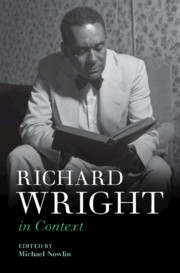Book contents
- Richard Wright in Context
- Richard Wright in Context
- Copyright page
- Contents
- Figures
- Contributors
- Abbreviations
- Richard Wright’s Works: A Chronology
- Introduction Richard Wright’s Luck
- Part I Life and Career, Times and Places
- Part II Social and Cultural Contexts
- Chapter 6 Black Masculinity
- Chapter 7 Wright and African American Women
- Chapter 8 He Tried to Be a Communist
- Chapter 9 Liberalism and the Color Line
- Chapter 10 “The Same Stuff”
- Chapter 11 Moviegoers and Cinematic Seers in Wright’s Fiction
- Chapter 12 Clothing
- Chapter 13 “Defeat Measured in the Jumping Cadences of Triumph”
- Chapter 14 Wright and Religion
- Chapter 15 Bandung and Third-World Liberation
- Chapter 16 Black Paris, Hard-Boiled Paranoia, and the Cultural Cold War
- Part III Literary and Intellectual Contexts
- Part IV Reputation and Critical Reception
- Index
Chapter 9 - Liberalism and the Color Line
from Part II - Social and Cultural Contexts
Published online by Cambridge University Press: 08 July 2021
- Richard Wright in Context
- Richard Wright in Context
- Copyright page
- Contents
- Figures
- Contributors
- Abbreviations
- Richard Wright’s Works: A Chronology
- Introduction Richard Wright’s Luck
- Part I Life and Career, Times and Places
- Part II Social and Cultural Contexts
- Chapter 6 Black Masculinity
- Chapter 7 Wright and African American Women
- Chapter 8 He Tried to Be a Communist
- Chapter 9 Liberalism and the Color Line
- Chapter 10 “The Same Stuff”
- Chapter 11 Moviegoers and Cinematic Seers in Wright’s Fiction
- Chapter 12 Clothing
- Chapter 13 “Defeat Measured in the Jumping Cadences of Triumph”
- Chapter 14 Wright and Religion
- Chapter 15 Bandung and Third-World Liberation
- Chapter 16 Black Paris, Hard-Boiled Paranoia, and the Cultural Cold War
- Part III Literary and Intellectual Contexts
- Part IV Reputation and Critical Reception
- Index
Summary
As Richard Wright was establishing his career in the 1940s, he maintained profitable but uneasy relationships with white audiences, especially those approaching his works within the political liberalism that held sway over much of American culture in this period. While Wright’s works struck a powerful chord in redirecting American culture to acknowledge the costs of race-based exclusion, the extent of that change was only ever partial, and often depended on Wright’s narratives being disseminated and received along the lines of established, white cultural parameters. At the same time, the commercial and critical successes of Native Son and Black Boy established the foundation for Wright’s career, and his interactions with white writers, living and dead, provided influential models and connections. This essay explores this tension while situating Wright’s work and publishing history in relation to civil rights activism and cultural liberalism in the 1940s, and its (sometimes distorted) reflection in the images of Wright circulated by his publishers and the mainstream press, by tracing the paratextual materials attached to Wright’s books and the wide range of publication venues in which his stories and essays appeared.
- Type
- Chapter
- Information
- Richard Wright in Context , pp. 98 - 107Publisher: Cambridge University PressPrint publication year: 2021

